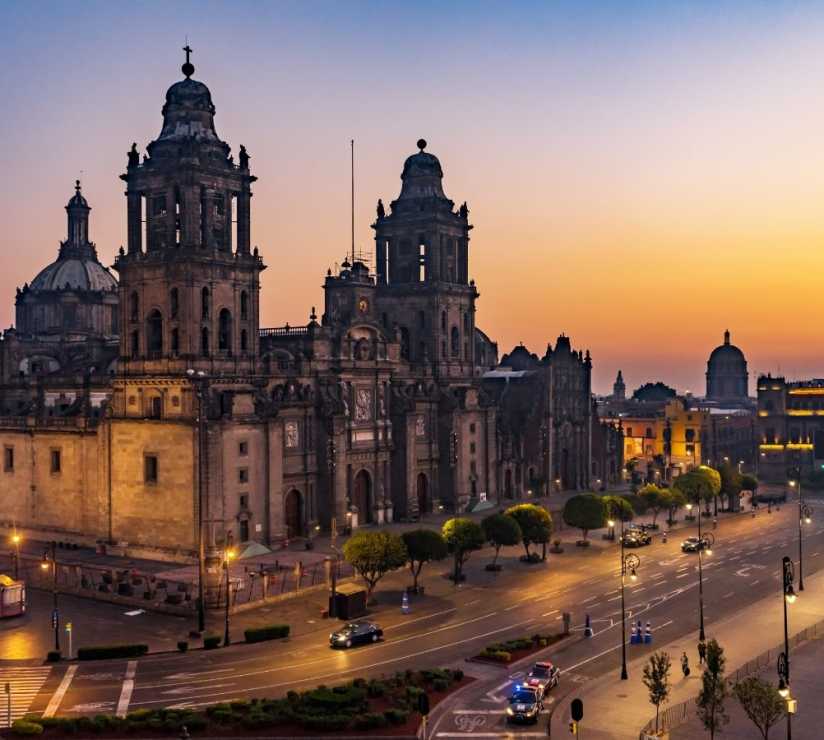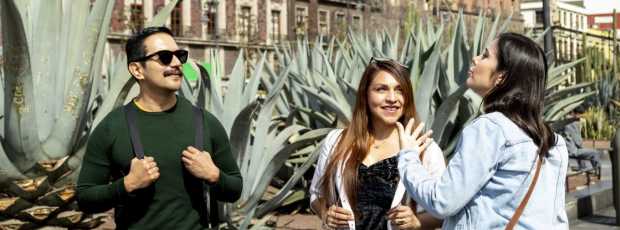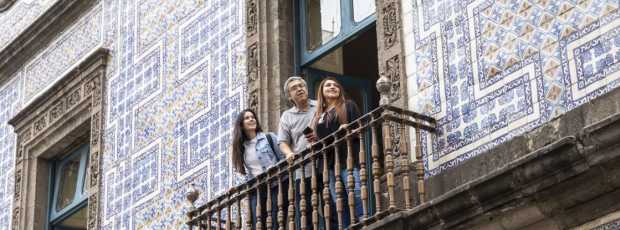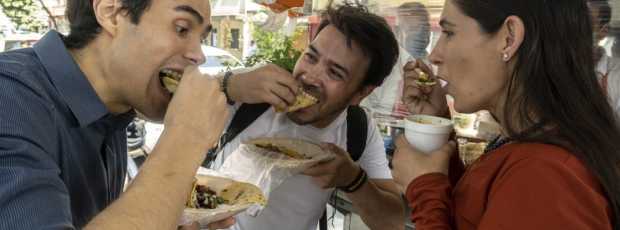Table Of Contents
- When the City Glows: December's Festive Atmosphere
- Following Ancient Paths: Templo Mayor and Mexico's Past
- Art in Season: Frida Kahlo Museum and Mexican Art
- Floating Through Time: Xochimilco's December Boat Ride
- Mountain Escape: Valle de Bravo Day Trip
- Green Refuge: Chapultepec Park's Winter Charm
- Where Twinkling Lights Tell Stories
- Sacred Spaces: Important Religious Sites
- Flavors of the Season: Local Delicacies
- Night Moves: Lucha Libre Show
- Hidden Gems and Authentic Moments
- Beyond the Tourist Trail
- Planning Your December Discovery
[HERO IMAGE: A festive street in Mexico City at night, with twinkling lights, vendors, and families walking. Filename: mexico-city-december-lights.jpg]
My abuela used to say that December in Mexico City smells like cinnamon and hope. As I write this from my neighborhood café in Roma Norte, watching families bundle up for evening posadas, I understand what she meant. December here isn't just a month, it's when our city transforms into something almost mythical, where ancient traditions dance with modern celebrations under winter skies that seem impossibly clear.
Experiences in Mexico City offer a tapestry of adventures that most visitors never discover. While tour groups rush between obvious attractions, the real magic happens in neighborhood posadas, at dawn markets fragrant with seasonal fruits, and in the quiet corners where this city's 700-year history whispers its secrets.
When the City Glows: December's Festive Atmosphere
The first thing that strikes you about Mexico City in December is the light. Not just the twinkling lights strung between buildings, but the quality of winter light itself. Golden, crisp, and somehow more generous than other months. Average temperatures hover around 20°C during the day, dropping to a refreshing 8°C at night, creating that perfect jacket weather.
I've lived here my entire life, and December still surprises me. Last week, walking through Centro Historico, I stumbled upon a spontaneous mariachi performance outside the Cathedral, their voices rising above the surrounding buildings in harmonies that seemed to capture the entire holiday season in five minutes of music. This is such a great place to live.
The festive atmosphere here isn't manufactured for tourists, it's woven into daily life. Children practice their Christmas pageant songs in neighborhood plazas. Vendors set up elaborate nativity scenes alongside their usual wares. Even the most ordinary street corners seem touched by holiday cheer, transformed by paper flowers and the scent of roasting chestnuts.
This is what makes things to do in Mexico City in December so special: you're not watching a performance of Mexican culture, you're living inside it.
Following Ancient Paths: Templo Mayor and Mexico's Past
December mornings at Templo Mayor feel different. Maybe it's the way the winter light hits the ancient stones, or how the cooler air seems to carry whispers of ceremonies performed here six centuries ago. This archaeological site, hidden beneath our modern city for centuries, reveals layers of Mexico's past that no textbook could capture.
I bring my nieces here every December, not because it's educational, but because something about this season makes the connection between past and present feel tangible. The museum's impressive collection includes offerings left by Aztec priests. Turquoise, obsidian, and jade that once caught firelight in these same spots where we now stand under December sun.
The surrounding buildings; the Cathedral, the Palacio Nacional, seem to lean in closer during December, as if the entire square conspires to create moments of reflection. Standing here, you understand that Mexico City isn't just built on ancient ruins; it's in conversation with them, especially during this season when tradition feels most alive.
What makes a visit to Templo Mayor essential during a December visit isn't just its historical significance, but how it anchors you in Mexico City's deeper rhythms before you explore the rest of the city.
Looking for a private city experience in Mexico City?
Explore the city with a local who plans a private day just for you; no groups, no scripts.
Art in Season: Frida Kahlo Museum and Mexican Art
The Frida Kahlo Museum takes on a different energy in December. Perhaps it's because winter light streams through the cobalt blue walls of her former home differently, or because the Day of the Dead flores de cempasúchil have given way to Christmas roses in the courtyard garden. Whatever the reason, visiting Casa Azul during this season feels like being invited into a very personal celebration.
Frida's personal belongings; her corsets, jewelry, and paintbrushes, seem more intimate in December's softer light. The museum, usually crowded with tour groups, finds quieter moments during weekday mornings when you can actually hear your own thoughts echo in her bedroom.
But Mexican art in December extends far beyond famous museums. In Roma Norte, galleries host special exhibitions that coincide with the season. Small artist studios open their doors for holiday sales, offering unique gifts that you'd never find in tourist shops. Last December, I discovered a printmaker whose work captured the exact shade of December light I'd been trying to describe to friends for years.
The National Museum of Anthropology also shifts during December. Fewer crowds mean you can actually spend time with the Aztec calendar stone, contemplating how ancient civilizations marked their own winter celebrations. The museum's impressive collection feels more accessible, more personal, when you're not fighting for space to appreciate it.
For those seeking authentic Mexico City experiences, December offers a chance to encounter art in its most natural setting. Not as tourist attractions, but as living expressions of culture that still shapes daily life here.
Floating Through Time: Xochimilco's December Boat Ride
Nothing prepares you for Xochimilco in December. The ancient floating gardens, now UNESCO World Heritage canals, take on an almost mystical quality when morning mist rises from the water and trajineras (colorful boats) drift past like something from a dream.
My family has been taking boat rides here for generations, and December remains my favorite time. The water reflects winter sky like polished silver, and the chinampas (artificial islands) show their agricultural bones more clearly when summer's lush growth has died back. You can actually see the engineering marvel that fed the Aztec empire, floating gardens that still produce food today.
During December, local families gather on trajineras for posadas celebrations. If you're lucky, you'll share the water with boats carrying entire extended families, mariachi musicians, and grandmother's famous ponche navideño. These aren't performances, they're real celebrations that happen to be beautiful.
The boat ride experience changes completely when you go during weekday mornings. Instead of party boats and loud music, you'll find fishermen checking their nets, birds returning from their morning hunt, and that particular quality of silence that only comes from being on water surrounded by ancient earth.
A December boat ride through Xochimilco offers something no other season can: the chance to understand how this city has always been defined by water, even when that relationship isn't immediately obvious from street level.
Mountain Escape: Valle de Bravo Day Trip
When Mexico City's December energy feels overwhelming, Valle de Bravo offers the perfect antidote. This colonial lakeside town, just two hours from the city, becomes a magical retreat.
I've been making this day trip every December for fifteen years, and it never gets old. The colonial architecture here feels completely different from Mexico City; smaller, more intimate, with cobblestone streets that seem designed for wandering rather than rushing. The main piazza, surrounded by cafés and artisan shops, hosts a different kind of holiday celebration than what you'll find in the capital.
But Valle de Bravo's real December magic happens in the surrounding mountains, where monarch butterflies cluster in oyamel fir forests after their 3,000-mile journey from Canada. Watching millions of monarch butterflies cover entire trees like living ornaments is one of those experiences that changes your understanding of what nature can accomplish.
The butterfly sanctuaries operate from November through March, but December offers the best balance of accessible weather and peak butterfly populations. Local guides - many from families who've lived in these mountains for generations - share knowledge about butterfly behavior that you won't find in guidebooks.
Valle de Bravo day trips work best when you leave Mexico City early, spend the morning with butterflies, explore, enjoy a long lunch by the lake, and return in evening light that turns the entire valley golden. It's the kind of day that makes you understand why people fall in love with Mexico.
What if your day in Mexico City was planned by someone who knows it — and you?
City Unscripted matches you with a local host who creates a private experience based on your interests, not a set route.
Green Refuge: Chapultepec Park's Winter Charm
Chapultepec Park transforms in December. The massive urban forest, larger than New York's Central Park, sheds summer's intense green for subtler winter colors that make its lakes, paths, and hidden corners feel more mysterious and inviting.
I run here most mornings, and December offers the best conditions; cool air, fewer crowds, and that particular quality of light that makes every tree look like it's posing for a photograph. The park's various sections reveal different personalities during winter: the cultural section with its museums feels more contemplative, while the recreational areas host family gatherings that spill over from indoor celebrations.
Chapultepec Castle, perched on the park's highest hill, becomes even more impressive in December's clear air. The former imperial residence offers views across Mexico City that stretch to snow-capped volcanoes on the horizon; a perspective that helps you understand this city's relationship with its dramatic geography.
The castle's exhibits about Mexican history feel more poignant during December, when the country's complex past mingles with holiday celebrations happening in the streets below. Standing in rooms where Emperor Maximilian once lived, looking out over a city celebrating traditions that predate his arrival by centuries, you experience Mexico's layered identity in a very immediate way.
What makes Chapultepec Park special in December isn't just its beauty, but how it serves as Mexico City's living room during the holiday season—a place where private family celebrations expand into shared public joy.
Where Twinkling Lights Tell Stories
Now, where can you see the most twinkling lights in Mexico City? The answer isn't simple, because the best lights here aren't concentrated in one tourist zone, they're woven through neighborhoods where real life happens.
Centro Historico gets the most attention, with the Zócalo's massive Christmas tree and light displays that draw tour groups. But the lights that move me most are smaller, more personal: the papel picado strung between apartment buildings in my neighborhood, the luminarias lining sidewalks during posadas, the single strand of lights around a taco stand that transforms it into something magical.
Roma Norte and Condesa host some of the city's most creative light displays. Art galleries and boutique hotels collaborate on installations that turn entire blocks into outdoor galleries. Walking these neighborhoods during December evenings feels like drifting through a city-sized art piece where every corner offers a new perspective on light and shadow.
But my favorite twinkling lights are the most temporary ones: the candles carried during posadas processions, the sparklers children light, the lanterns released during special celebrations. These lights tell stories about community, tradition, and the way Mexico City comes together during December.
The most beautiful lights in Mexico City aren't installations you can photograph easily; they're moments of illumination that happen when community celebration meets December's magical light.
Sacred Spaces: Important Religious Sites
December in Mexico City means encountering faith in its most public and joyous expressions. The Basilica of Our Lady of Guadalupe becomes an important religious site not just for its historical significance, but for the way it anchors holiday celebrations across the entire city.
I'm not particularly religious, but December at the Basilica moves me every year. The constant stream of pilgrims, many traveling from far-off states, creates an atmosphere of devotion that transcends any single denomination. Watching families pray together, leave flowers, and light candles, you witness faith as it actually exists in Mexican culture; communal, celebratory, and intricately woven with daily life.
The smaller churches scattered throughout Mexico City neighborhoods take on special significance during December. Each parish hosts its own posadas, nativity displays, and special masses that reflect the particular character of their communities. In Roma Norte, churches blend traditional celebrations with contemporary artistic expressions. In older neighborhoods, celebrations maintain forms that haven't changed in centuries.
What makes religious sites special during December isn't just their architectural beauty or historical importance, but how they become stages for Mexico City's most authentic cultural expressions. Even if you don't share the specific faith, you can appreciate the artistry, community connection, and continuity these celebrations represent.
The Basilica of Our Lady of Guadalupe and smaller neighborhood churches offer windows into how Mexican spirituality actually functions during the holiday season. Not as tourist attractions, but as living centers of community life.
Tip
We match you with the right host, not just any guide.Want to experience the real Mexico City with someone who lives there?
A fully private experience, planned and led by a local host who tailors the day to you
Flavors of the Season: Local Delicacies
December in Mexico City tastes different than any other month. Street vendors selling tejocotes, jícamas, and sugar cane create a symphony of seasonal flavors that you can't experience anywhere else or at any other time.
My December food ritual starts with ponche navideño. Christmas punch made with tejocotes, cinnamon, piloncillo, and often a splash of rum. Every family has their own recipe, and every neighborhood café serves a slightly different version. The drink embodies everything about Mexican December: warming, communal, and impossible to rush.
Local delicacies during December extend beyond special drinks. Tamales reach their seasonal peak. Every family making massive batches for Christmas celebrations. The corn masa, filled with everything from sweet pineapple to complex moles, represents hours of collective kitchen work that transforms individual ingredients into shared memories.
Street food also shifts during December. Esquites vendors add seasonal toppings like dried chilies and lime that complement winter's cooler temperatures. Churros become more elaborate, filled with cajeta or chocolate. Even simple quesadillas taste different when eaten while watching Christmas lights reflect in sidewalk puddles.
The most authentic local delicacies aren't found in restaurants, they're shared in homes, sold by vendors, and discovered through the kind of wandering that only happens when you have time to pay attention to what your nose is telling you.
Night Moves: Lucha Libre Show
Arena México transforms on December evenings. The iconic wrestling venue, where lucha libre has been performed for over 80 years, takes on a festive atmosphere that makes the already theatrical experience even more magical.
I've been attending lucha libre shows since childhood, and December matches feel different. Maybe it's the holiday spirit, or maybe the wrestlers themselves get caught up in seasonal excitement, but the performances seem more elaborate, more joyous, more connected to celebration than competition.
A lucha libre show during December isn't just entertainment, it's an introduction to Mexican storytelling traditions. The good guys (técnicos) and villains (rudos) represent archetypal struggles that resonate across Mexican culture. When children in the audience cheer for their heroes, they're participating in narratives that connect to much older traditions about justice, community, and triumph over adversity.
The atmosphere around Arena México on December evenings extends the experience beyond the arena itself. Street vendors sell masks, corn on the cob, and beer. Families arrive early to soak in the pre-show energy. The entire neighborhood becomes part of the lucha libre experience.
December lucha libre shows offer something unique: the chance to experience Mexican popular culture in its most authentic setting, surrounded by local families treating wrestling night as a cherished holiday tradition.
Hidden Gems and Authentic Moments
The real hidden gems of December in Mexico City aren't secret locations; they're moments of authentic connection that happen when you're paying attention to daily life rather than checking attractions off a list.
Last December, waiting for a bus in Coyoacán, I ended up in conversation with an elderly woman who invited me to her granddaughter's posada that evening. Three hours later, I was helping carry a piñata, singing villancicos, and learning family recipes that had been passed down for generations. This kind of spontaneous inclusion happens regularly in Mexico City during December, the city opens its doors wider during the holiday season.
The hidden gems I recommend aren't exotic locations but ordinary places experiencing December magic: the early morning market where vendors start each day by decorating their stalls with papel picado; the neighborhood where children practice Christmas carols after school; the corner café where regulars gather to debate the best places to buy Christmas trees.
Real Mexico City reveals itself when you slow down enough to notice patterns, conversations, and celebrations that happen whether or not tourists are watching. December amplifies these moments because the entire city participates in shared traditions that bridge class, neighborhood, and generational differences.
The most valuable hidden gems aren't places you can pin on a map; they're opportunities to witness and participate in Mexico City's authentic cultural life during its most celebratory season.
Ready to plan your perfect day in Mexico City?
Start your experienceBeyond the Tourist Trail
December's neighborhood posadas aren't performed for visitors, they're nine-night celebrations that culminate on Christmas Eve, representing Mary and Joseph's search for shelter.
Each neighborhood organizes posadas differently, but they all involve community participation that welcomes newcomers. Last year, visitors staying in my friend's Airbnb ended up carrying part of the nativity scene during our local posada. By the end of the evening, they understood something about Mexican community life that no museum could teach.
Beyond tourist trails also means discovering Mexico City's relationship with December weather and light. The dry season creates perfect conditions for walking, but more importantly, it changes how the city sounds and smells. December air carries sounds further—you'll hear conversations, music, and celebrations from blocks away. The city becomes more acoustic, more connected.
The experiences that matter most happen when you treat Mexico City as a place where people live, work, and celebrate rather than as a collection of attractions to visit. December offers the perfect season for this kind of discovery because the entire city participates in traditions that make daily life more visible, more welcoming, and more connected to its deeper cultural roots.
Planning Your December Discovery
December in Mexico City isn't just a time to visit, it's a season to experience how Mexican culture actually functions when it's celebrating itself rather than performing for outsiders. The things to do in Mexico City in December aren't activities you complete, but opportunities to participate in traditions that reveal what makes this city extraordinary.
My recommendation is simple: come with enough time to let December's rhythm slow you down. Skip the rushed itinerary. Instead, pick a neighborhood; Roma Norte, Coyoacán, or Centro Historico, and explore it deeply. Attend a posada if you're invited. Try street food you've never heard of. Follow the sound of music around corners. Let twinkling lights lead you down streets you hadn't planned to walk.
December here teaches you that the best travel experiences aren't things you do; they're ways of being present in places where life is already happening beautifully. Mexico City in December doesn't need you to discover it. It needs you to let it discover you.
The magic my abuela described; that smell of cinnamon and hope, isn't something you find in guidebooks. It's something that finds you when you're walking down a December street in Mexico City, paying attention to the light, the sounds, and the way this ancient, modern, impossible city celebrates the season when darkness gives way to longer days and deeper connections.
What if your day in Mexico City was planned by someone who knows it — and you?
City Unscripted matches you with a local host who creates a private experience based on your interests, not a set route.
Want to experience the real Mexico City with someone who lives there?
A fully private experience, planned and led by a local host who tailors the day to you











